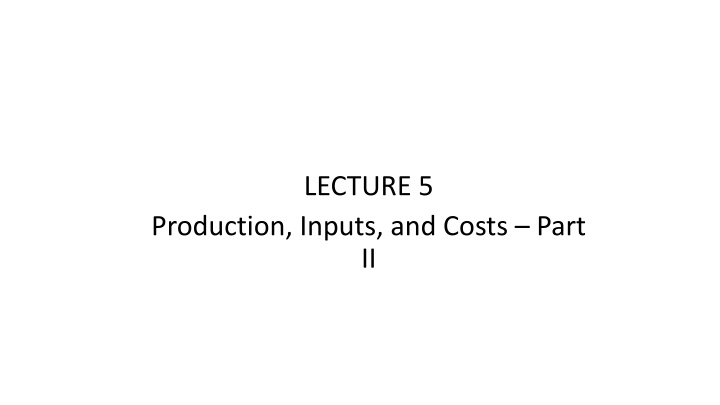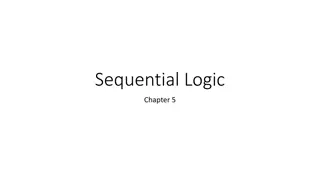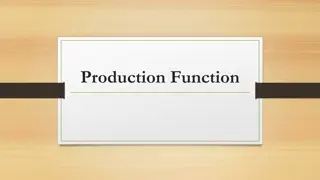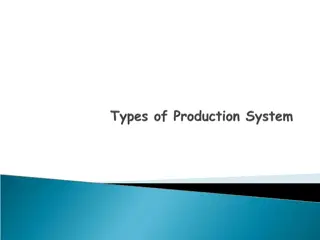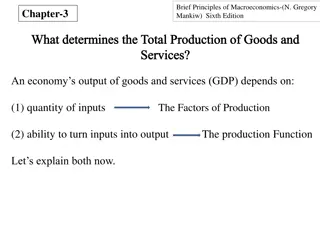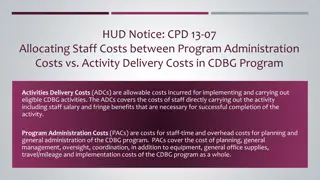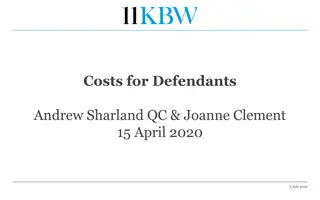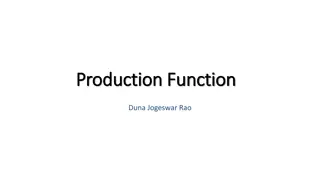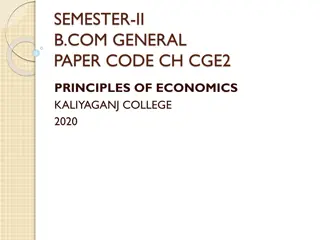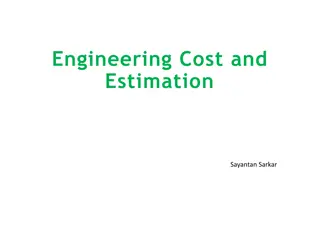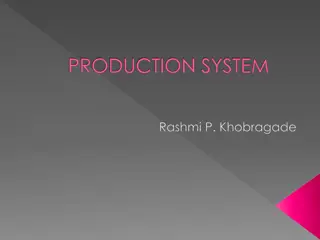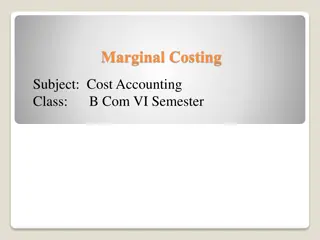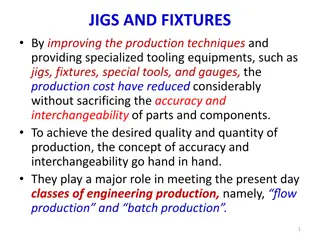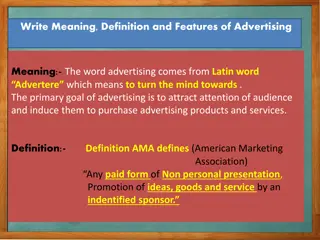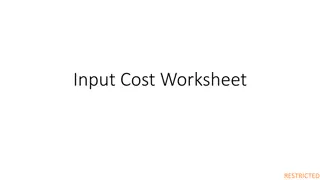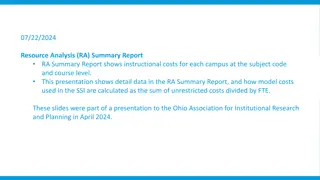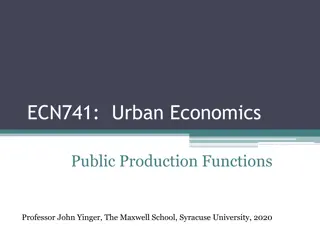Production Inputs and Costs Analysis
This session covers optimal input choices, total cost in relation to output, marginal and average costs, cost-output analysis, and economies of scale in production. Learn how firms determine the most profitable input choices and make optimal spending decisions on labor and capital for maximizing revenue.
Download Presentation

Please find below an Image/Link to download the presentation.
The content on the website is provided AS IS for your information and personal use only. It may not be sold, licensed, or shared on other websites without obtaining consent from the author.If you encounter any issues during the download, it is possible that the publisher has removed the file from their server.
You are allowed to download the files provided on this website for personal or commercial use, subject to the condition that they are used lawfully. All files are the property of their respective owners.
The content on the website is provided AS IS for your information and personal use only. It may not be sold, licensed, or shared on other websites without obtaining consent from the author.
E N D
Presentation Transcript
LECTURE 5 Production, Inputs, and Costs Part I
Review of the Previous Session The production technology Production in the short run Optimal input choices in the short run Production in the long run
Road map Input choices in the long run Total cost and its dependence on output Marginal and average costs and output dependence Costs and dependence on output-graphical analysis Economies of scale
Introduction to Production, Inputs, and Costs Which input choices are the most profitable ones for firms to produce a specific quantity of their product? We proceed in three steps: 1. How inputs affect output 2. How firms select the optimal amount of inputs to produce a specific quantity of their product/service 3. How those inputs affect the cost of production at different output quantities
Optimal Input Choices in The Long-Run How should the firm decide how much to spend on capital (K) and how much on labor (L)? Compare the extra revenue that an extra dollar spent on capital generates to the extra revenue that an extra dollar spent on labor creates
Finding the Optimal Input Choices in The Long-Run If the marginal revenue of spending one extra dollar on labor > than the marginal revenue of spending one extra dollar on capital ??? ? >??? ? Where: Marginal revenue of labor: MRL =MPL x P MPL: marginal product of labor P: per unit price of firm s output W: per unit price of labor input Marginal revenue of capital: MRK = MPK x P MPK: marginal product of capital P: per unit price of firm s output r: per unit price of capital input Increase spending on labor, less on capital
Finding the Optimal Input Choices in The Long-Run (cont.) If the marginal revenue of spending one extra dollar on labor < than the marginal revenue of spending one extra dollar on capital ??? ? <??? ? Where: Marginal revenue of labor: MRL =MPL x P MPL: marginal product of labor P: per unit price of firm s output W: per unit price of labor input Marginal revenue of capital: MRK = MPK x P MPK: marginal product of capital P: per unit price of firm s output r: per unit price of capital input Increase spending on capital, less on labor
Optimal Input Choices in The Long-Run If the marginal revenues of an additional dollar spent on either labor or capital are the same ??? ? =??? ? Where: Marginal revenue of labor: MRL =MPL x P MPL: marginal product of labor P: per unit price of firm s output W: per unit price of labor input Marginal revenue of capital: MRK = MPK x P MPK: marginal product of capital P: per unit price of firm s output r: per unit price of capital input Use this combination of capital and labor
Example: Fords Production Schedule Marginal Revenue MR = MPL * P (in thousands) Price (P) per unit of output (in thousands) Wage (W) per worker (in thousands) Amount of labor (L) Total Product (q) Marginal Product of Labor MPL = ( q/ L) 0 0 15 50 1 4 4 60 15 50 2 12 8 120 15 50 3 24 12 180 15 50 4 32 8 120 15 50 5 35 3 45 15 50 6 30 -5 -75 15 50
Example: Fords Production Schedule M R L of 2nd employee = $120,000 M R L / W = $120,000 / $50,000 = $2.40 Says that if Ford spends $1 more on labor, the M R L = $2.40 Suppose if Ford spends $1 more on tools, the M R K = $5.00 Ford should spend the $1 on tools first
Road map Input choices in the long run Total cost and its dependence on output Marginal and average costs and output dependence Costs and dependence on output-graphical analysis Economies of scale
Introduction to Production, Inputs, and Costs Which input choices are the most profitable ones for firms to produce a specific quantity of their product? We proceed in three steps: 1. How inputs affect output 2. How firms select the optimal amount of inputs to produce a specific quantity of their product/service 3. How those inputs affect the cost of production at different output quantities
Total Cost of Production How do the optimal input choices affect the cost of producing different levels of output? The most desirable quantity the firm would like to produce depends on how costs change as output varies
Total Cost of Production Total Cost (TC): the sum of all the input costs Based on the optimal input quantities And their per unit prices We can find the Total Cost In the example of the car industry: Total cost of cars = (number of workers x wage per worker) + ( number of buildings x purchase cost of the building) + (quantity of steel x per unit price of steel) + (electricity x per unit price of electricity)
Fixed and Variable Costs Do all costs depend on the amount of output the firm produces? No Some costs vary with output, while others remain unchanged as long as the firm is producing any output at all. We divide the Total Cost (TC) into: Fixed Cost (FC): it does not change with output. Variable Cost (VC): it varies as output varies TC = FC + VC
Fixed and Variable Costs Example of Fixed Costs (FC) Expenditures for plant maintenance Insurance Electricity Example of Variable Costs (VC) Wages Expenditures for raw materials
Example of a Firms Costs Output (units per year) Fixed Cost ($ per year) Variable Cost ($ per year) Total Cost ($ per year) Marginal Cost ($ per unit) Average Fixed Cost ($ per unit) Average Variable Cost ($ per unit) Average Total Cost ($ per unit) (q) (FC) (VC) (TC) (MC) (AFC) (AVC) (ATC) 0 1 2 3 4 5 6 7 8 9 50 50 50 50 50 50 50 50 50 50 50 50 0 50 100 128 148 162 180 200 225 254 292 350 435 50 78 98 112 130 150 175 204 242 300 385 50 28 20 14 18 20 25 29 38 58 85 50 25 50 39 100 64 49.3 40.5 36 33.3 32.1 31.8 32.4 35 39.5 16.7 12.5 10 8.3 7.1 6.3 5.6 32.7 28 26 25 25 25.5 26.9 30 35 10 11 5 4.5
Firms Costs When output is zero The Fixed Cost is still $50 per year (rent, electricity) The Variable Cost is zero (workers, raw materials) Total Cost is the sum of the Fixed Cost and Variable Cost
Road map Input choices in the long run Total cost and its dependence on output Marginal and average costs and output dependence Costs and dependence on output-graphical analysis Economies of scale
Example of a Firms Costs Output (units per year) Fixed Cost ($ per year) Variable Cost ($ per year) Total Cost ($ per year) Marginal Cost ($ per unit) Average Fixed Cost ($ per unit) Average Variable Cost ($ per unit) Average Total Cost ($ per unit) (q) (FC) (VC) (TC) (MC) (AFC) (AVC) (ATC) 0 1 2 3 4 5 6 7 8 9 50 50 50 50 50 50 50 50 50 50 50 50 0 50 100 128 148 162 180 200 225 254 292 350 435 50 78 98 112 130 150 175 204 242 300 385 50 28 20 14 18 20 25 29 38 58 85 50 25 50 39 100 64 49.3 40.5 36 33.3 32.1 31.8 32.4 35 39.5 16.7 12.5 10 8.3 7.1 6.3 5.6 32.7 28 26 25 25 25.5 26.9 30 35 10 11 5 4.5
Marginal Cost Marginal Cost (MC): How much does the total cost change when output changes by one unit? TC q ?? = The Marginal Cost is equal to the change in the Variable Cost Since the Fixed Cost does not change with output TC q= FC ?+ ?? q= 0 + VC q ?? =
Marginal Cost Example: If output increases from 2 units to 3 units The Marginal Cost is $20 dollars By increasing its output by one more unit from 2 units, the firm will face an additional $20 cost The Variable Cost of the firm increases from $78 to $98
Average Total Cost Average Total Cost (ATC or AC): The average cost of the firm (the per-unit cost of production) ??? = ? ?? The Average Total Cost has two components: The Average Fixed Cost (AFC) = ?? The Average Variable Cost (AVC) = ?? ? ? ?? ?+?? ??? = ??? + ??? = ?
Road map Input choices in the long run Total cost and its dependence on output Marginal and average costs and output dependence Costs and dependence on output-graphical analysis Economies of scale
Example of a Firms Costs Output (units per year) Fixed Cost ($ per year) Variable Cost ($ per year) Total Cost ($ per year) Marginal Cost ($ per unit) Average Fixed Cost ($ per unit) Average Variable Cost ($ per unit) Average Total Cost ($ per unit) (q) (FC) (VC) (TC) (MC) (AFC) (AVC) (ATC) 0 1 2 3 4 5 6 7 8 9 50 50 50 50 50 50 50 50 50 50 50 50 0 50 100 128 148 162 180 200 225 254 292 350 435 50 78 98 112 130 150 175 204 242 300 385 50 28 20 14 18 20 25 29 38 58 85 50 25 50 39 100 64 49.3 40.5 36 33.3 32.1 31.8 32.4 35 39.5 16.7 12.5 10 8.3 7.1 6.3 5.6 32.7 28 26 25 25 25.5 26.9 30 35 10 11 5 4.5
Costs Graphical Analysis In panel (a): The FC is constant The VC is zero when q =0 The TC is the vertical addition of the VC and FC curves The VC and TC rise as output increases In panel (b): The AFC falls since the FC is constant The ATC is the vertical sum of AVC and AFC; since AFC declines, this distance gets smaller As output increases, the FC is distributed among more units of output, and the ATC is mostly affected by the AVC
The U-Shape of the ATC The ATC curve decreases initially as output increases: 1. The AFC part of the ATC curve declines as output increases: The FC is spread over more units as output increases 2. The Marginal Product initially rises, as the quantity of the input increases. As a result, the average costs decrease initially.
The U-Shape of the ATC The ATC curve increases after some point as output increases: 1. Increasing administrative costs 2. Diminishing marginal returns take an effect At what output level average costs start to rise varies from one industry to another Depends on relative size of fixed costs
Road map Input choices in the long run Total cost and its dependence on output Marginal and average costs and output dependence Costs and dependence on output-graphical analysis Economies of scale
Economies of Scale Important link between the scale of a firm s operation and its cost Economies of scale: The firm can double its output for less that twice the cost Diseconomies of scale: Doubling output requires more than twice the cost
Factors that Can Cause Economies of Scale 1. Large scale allows workers to specialize in what they are most productive Team project of 4 people vs. 2 people 2. Scale can provide flexibility; different combinations of inputs can produce the same output Larger firms can utilize automation easier 3. Large purchases of inputs can result is great discounts and offers Amazon and USPS
Factors that Can Cause Diseconomies of Scale 1. Factory space and machinery may make it harder for workers to do their jobs effectively 2. Managing a larger firm may become complex 3. The advantage of buying in bulk may disappear with larger quantities Available supplies of key inputs can reach their limits, pushing their costs up
The Tesla puzzle - Solved Ever since Tesla s founding in 2003, it has been known for its sleek electric cars that resemble vehicles of the future. With prices starting at around $85,000 for the Model S sedan, the cars have been unaffordable for most people. And the reason for this cost had nothing to go with safety. Tesla was going to produce a new mass market car, the Modal 3 starting in 2017 With a starting price of about $35,000 How would such a reduction in the price be possible? We are talking about a 59% reduction in the price.
The Tesla puzzle - Solved THE EFFECT OF EFFLUENT FEES ON INPUT CHOICES To achieve this reduction in price, Tesla will rely on scale economies in battery production in its $5 billion Gigafactory in Nevada Battery costs are expected to decrease by one-third (to about $250 per kWh of energy storage), and fall further as production rises TESLA S AVERAGE COST OF BATTERY PRODUCTION The average battery production cost was about $400 per kWh in 2016 The battery for Tesla s Model 3 has a 50 kWh capacity, which at $400 per kWh implies a cost of $20,000 per battery That cost can be decreased by producing batteries in large volumes The goal of Tesla s Gigafactory is a high volume of production
Economies of Scale: 3 Industries That Benefit Most, U.S. News & World Report, Aug. 2021 1. Regulated Utilities Regulated utilities are the textbook example of economies of scale. Providing a utility requires the development of massive infrastructure building out the plant, laying the distribution network and reaching every customer making fixed costs for these projects incredibly high. Once established, though, the cost of the actual natural resources to create the utility is comparably low. As a result, many utilities experience economies of scale large enough to constitute a natural monopoly, as many Americans have just one electricity, water or gas provider in their area. In much of the U.S., utilities are still a privately provided service and state or local government allows the monopoly to exist but regulates prices and practices to put a damper on aggressive behavior.
Economies of Scale: 3 Industries That Benefit Most, U.S. News & World Report, Aug. 2021 1. Regulated Utilities (cont.) "The basic idea is to recognize that four different competitors building out an electric grid is not efficient, but let's not allow them to charge as high a price as a profit-maximizing monopolist would like to," Handy says. For investors, this means that utility companies are largely insulated from competition, receive predictable cash flows and are able to pay consistent dividends. "As long as these firms manage their cost side, they will do fine," says Derek Horstmeyer, a professor of finance at George Mason University in Fairfax, Virginia. This makes strong and stable management teams especially important for these firms. Who benefits from investing in regulated utilities? "Somebody near retirement, who is a little more risk-averse, because the stable dividends and regulation allow utilities to act like a safe stock," Horstmeyer says. Even in difficult economic times, everyone needs power and water, making utilities practically recession-proof and a defensive play for a portfolio.
Economies of Scale: 3 Industries That Benefit Most, U.S. News & World Report, Aug. 2021 1. Regulated Utilities (cont.) Duke Energy Corp. (ticker: DUK), which provides power to 7.2 million Americans, is a traditional utility stock that has paid a quarterly dividend for 95 straight years, and this past year marked the 15th consecutive year of dividend increases. Another of the biggest names in U.S. utilities stocks is Southern Co. (SO), an Atlanta-based company that operates a wide variety of power plants and uses nuclear, wind, solar, hydroelectric and traditional fossil fuels. Last year, the company raked in $3.15 billion in net income, and the stock carries a 4.1% dividend yield.
Economies of Scale: 3 Industries That Benefit Most, U.S. News & World Report, Aug. 2021 2. Auto Manufacturing Developing a new vehicle is a massive undertaking just take a look at Tesla Inc.'s (TSLA) long journey to efficient production. Founded in 2003, it turned its first yearly profit in 2020. Modern cars contain massive amounts of technology, including software, computers and sensors, while still requiring all the same raw materials as your father's Toyota. The development of each specialized component requires extensive research and design, and putting all the pieces together requires a massive amount of coordination, from laying out the factory and bringing in specialized machinery to organizing the assembly process. Thus, the auto manufacturing industry has huge fixed costs, but the "marginal costs labor, metal and materials though not trivial, are comparatively low relative to these startup costs," Handy says. In economic terms, the auto industry functions as an oligopoly, Handy says. Consumers have a number of options to choose from, and many brands compete for market share. However, several of these brands operate under the same umbrella.
Economies of Scale: 3 Industries That Benefit Most, U.S. News & World Report, Aug. 2021 2. Auto Manufacturing (cont.) Toyota Motor Corp. (TM) makes Toyota, Lexus and Scion vehicles and has minority stakes in Suburu and Suzuki. General Motors Co. (GM) manufactures the Buick, Cadillac, Chevrolet and GMC brands, while Volkswagen (VWAGY) makes Audi, Bentley, Bugatti, Lamborghini, Porsche and Volkswagen. The presence of large, established companies combined with high startup costs creates a significant barrier to entry. Elon Musk and Tesla first teased the Model 3 as affordable for the average consumer in 2006, but it took until mid-2017 for the company to begin even limited production, finishing the year with a mere 1,667 vehicles sold. Today, Tesla has the largest market capitalization of any auto manufacturer in the world, yet its vehicle sales still lag behind those of legacy automakers. In 2020, Tesla sold 217,600 vehicles, while GM, Toyota, and Ford (F) all sold more than 2 million each.
Economies of Scale: 3 Industries That Benefit Most, U.S. News & World Report, Aug. 2021 2. Auto Manufacturing (cont.) But the auto industry is undergoing a massive transition, and in 20 years, it's possible that almost all new car sales will be electric vehicles. Traditionally, economies of scale would provide a good defense against Tesla and other startups, but the big thing now is battery technology, Horstmeyer says, and it's unclear which firms will take the lead. One auto stock to watch is Stellantis NV (STLA), which formed Jan. 16, 2021, following the merger of French automaker PSA Group and Italian automaker Fiat Chrysler. Brands under their umbrella now include Chrysler, Dodge, Fiat, Jeep, Maserati and Ram. Mergers enhance economies of scale, and Stellantis would have been the fourth-largest global automaker in 2020. Morningstar analysts are bullish on the stock, giving it a fair-value estimate of $33. The stock traded for less than $21 as of early August 2021.
Economies of Scale: 3 Industries That Benefit Most, U.S. News & World Report, Aug. 2021 3. Software Companies and Data Centers Big software companies also experience economies of scale, though not through the same methods as utilities and auto manufacturers. Microsoft Corp. (MSFT), for instance, hires a bunch of developers, engineers and managers to produce a product like Microsoft Office, but providing the billionth user with a copy is essentially free for Microsoft. All the work and the fixed costs are tied up in developing the software itself. The software industry has high gross margins because after development, the companies' biggest expense is persuading people to purchase their product, Horstmeyer says. Once again, these marketing costs remain comparatively low relative to research and design, allowing these firms to benefit from substantial economies of scale as they grow.
Economies of Scale: 3 Industries That Benefit Most, U.S. News & World Report, Aug. 2021 3. Software Companies and Data Centers (cont.) Data centers have also emerged as a sector with important economies of scale. Amazon Web Services, Amazon.com Inc.'s (AMZN) division that offers cloud-based solutions for businesses and consumers, incurred huge fixed costs building out their data centers, but now the cost of running the center is comparatively low: a few employees and a lot of electricity. In 2020, AWS booked more than $13.5 billion in operating profit, which represented more than 63% of Amazon's total operating profit, making AWS by far its most profitable division. In fact, cloud computing and big data are so profitable that traditional real estate plays, such as real estate investment trusts, or REITs, have started investing in properties that house data centers, Horstmeyer says.
Economies of Scale: 3 Industries That Benefit Most, U.S. News & World Report, Aug. 2021 3. Software Companies and Data Centers (cont.) Looking to the future, data centers could become a sort of privately held but publicly regulated utility, due to their high fixed costs, large barriers to entry and the essential services they provide to Americans. "If hacking between countries grows even worse, these data centers could become highly regulated for national security reasons, giving them similar properties to utility providers," Horstmeyer says. If you are looking for economies of scale to drive future growth in your portfolio as opposed to consistent value, software companies and data centers could be a good addition. In this space, it's hard to go wrong with the FAANG stocks Facebook Inc. (FB), Amazon, Apple Inc. (AAPL), Netflix Inc. (NFLX), and Alphabet Inc. (GOOGL) but beyond the basics, look toward data center REITs, such as Equinix (EQIX) and Digital Realty (DLR), which dominate the sector.
Takeaways In the long run, the firm has more flexibility in choosing the right combination of inputs In the long run, firms select the optimal amount of inputs according to the condition: ???/?=???/? The decision how much to produce depends on the effect that output has on the cost of production The total cost has two components: FC + VC The behavior of the ATC (U-shape) is explained by two factors Economies of scale can reduce the cost of production and increase profitability
